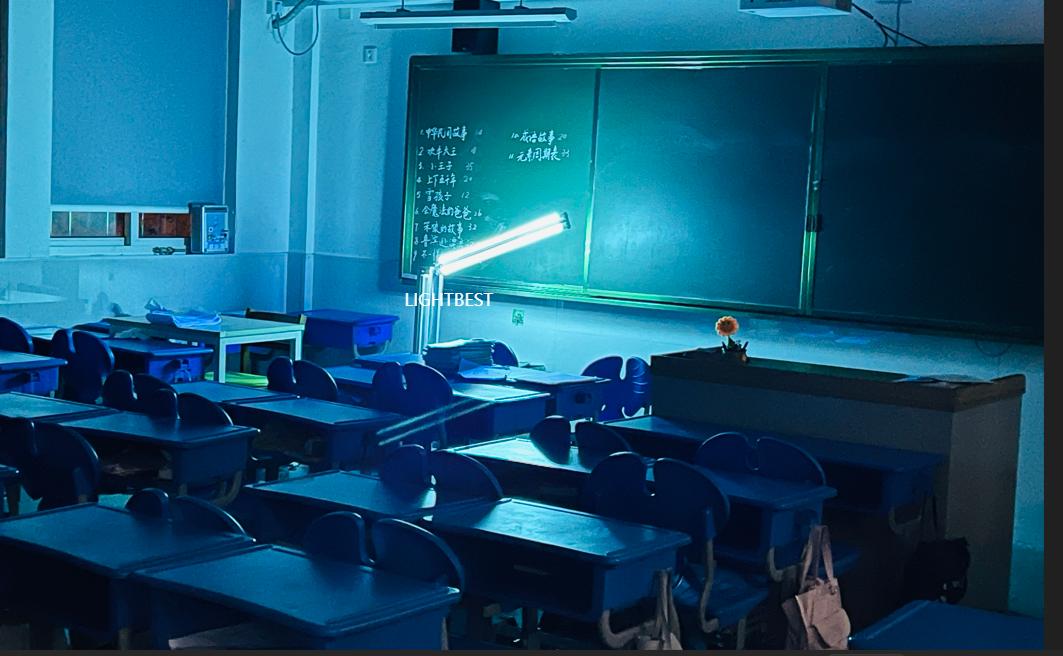The operating time of indoor UV germicidal lamps should be determined based on a combination of factors, including the type of space, disinfection targets, equipment specifications, and environmental conditions. The following is a detailed analysis and recommendation:
I. Core Factors Affecting Disinfection Time
1.Ultraviolet (UV) Intensity (μW/cm²)
l UV intensity is the primary parameter determining disinfection effectiveness. It is usually indicated in the product specifications (e.g., a 30W UV lamp typically has an intensity of ≥70μW/cm²).
l Intensity degradation: The intensity of UV lamps decreases over time (approximately 8,000 hours of use). Regular testing is required to monitor intensity and adjust disinfection time accordingly.
2.Distance and Obstructions
l Distance effect: UV intensity follows the inverse square law, meaning it decreases rapidly with distance (e.g., 100% intensity at 1 meter drops to 25% at 2 meters).
l Obstructions: Items like furniture or fabrics can block UV rays. To ensure complete coverage, avoid shaded areas by using mobile UV disinfection units or multi-lamp setups.

(UV sterilizing trolley used for on-site sterilization in a classroom (real-life photo))
3. Types and Density of Microorganisms
l Bacteria: Common bacteria (e.g., E. coli) typically require 30–60 minutes of exposure.
l Viruses: Highly pathogenic viruses (e.g., COVID-19) are recommended to be treated for 60–90 minutes, in combination with other disinfection measures.
l Spores: Require higher intensity and longer exposure time, typically 120 minutes or more.
4. Environmental Conditions
l Temperature and Humidity: Optimal effectiveness is achieved at temperatures between 20–40°C and humidity levels of 40–60%. Low temperatures or high humidity can reduce disinfection efficiency.
l Air Circulation: Doors and windows should be closed during disinfection to prevent ultraviolet rays from being diluted by airflow.
II. Recommended Disinfection Time for Different Scenarios
| Scenario
| Recommended Time | Notes |
Ordinary household room | 30–60 minutes | For rooms of 15–30㎡, with the lamp placed 1.8–2 meters above the floor, unobstructed. |
Hospital ward | 60–90 minutes | Focus on disinfecting high-touch surfaces (e.g., bed rails, tables); local exposure may be extended. |
Laboratory/Cleanroom | 90–120 minutes | Higher cleanliness standards required (e.g., ISO Class 5); recommended to use with ozone or hydrogen peroxide. |
School classroom | 45–60 minutes | Target surfaces like seats and handrails; should be used in conjunction with ventilation systems. |
Public transportation | 30-45 minutes | Target surfaces like seats and handrails; should be used in conjunction with ventilation systems. |
III. Safe Operation and Precautions
1.Personnel Evacuation and Protection
l Ultraviolet light can cause severe irritation to the skin and eyes. The area must be completely cleared of people and doors/windows closed during disinfection.
l Operators must wear protective goggles and clothing, especially when handling high-intensity UV equipment.
2. Regular Inspection and Maintenance
l Use UV intensity indicator cards (once per quarter) or professional instruments to check the lamp’s UV output.
l Clean the lamp surface weekly with an alcohol-soaked cotton ball to prevent dust buildup, which can reduce light transmittance.
3.Avoid Overexposure
l Extending disinfection time does not proportionally increase effectiveness (e.g., exceeding 120 minutes provides no significant benefit against most microorganisms).
l UV light can accelerate the aging of certain materials (such as plastics and fabrics); avoid direct exposure to sensitive items.
IV. Common Misconceptions and Recommendations
l Misconception 1: Ultraviolet light can penetrate objects for disinfection
Truth: UV light travels in a straight line and cannot penetrate materials like paper or glass. Surfaces must be directly exposed for effective disinfection.
l Misconception 2: It’s safe to enter the room immediately after disinfection
Recommendation: If the UV lamp generates ozone, ventilate the area for at least 30 minutes before re-entering to ensure safety.
l Misconception 3: Continue using the lamp even if it appears dim
Recommendation: Replace the lamp when its rated lifespan is reached or when UV intensity drops below 70%—typically, this means replacing it once a year.
V. Summary and Recommendations
l Basic scenarios: For home rooms, offices, and other standard environments, a disinfection duration of 30–60 minutes is recommended.
l High-risk scenarios: In places like hospitals or laboratories, 60–120 minutes is advised, ideally in combination with other disinfection methods.
l Dynamic adjustment: Adjust disinfection time based on UV intensity readings, environmental humidity and temperature, and the type of microorganisms present.
Key principle: To achieve efficient disinfection while ensuring safety, rely on a combination of intensity monitoring, optimized exposure time, and environmental control.
Post time:2025-05-07 14:03:07

